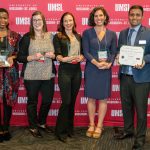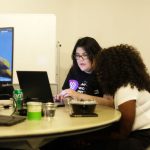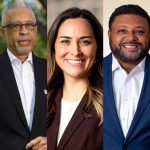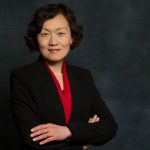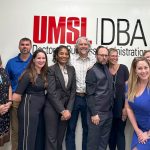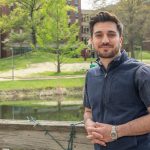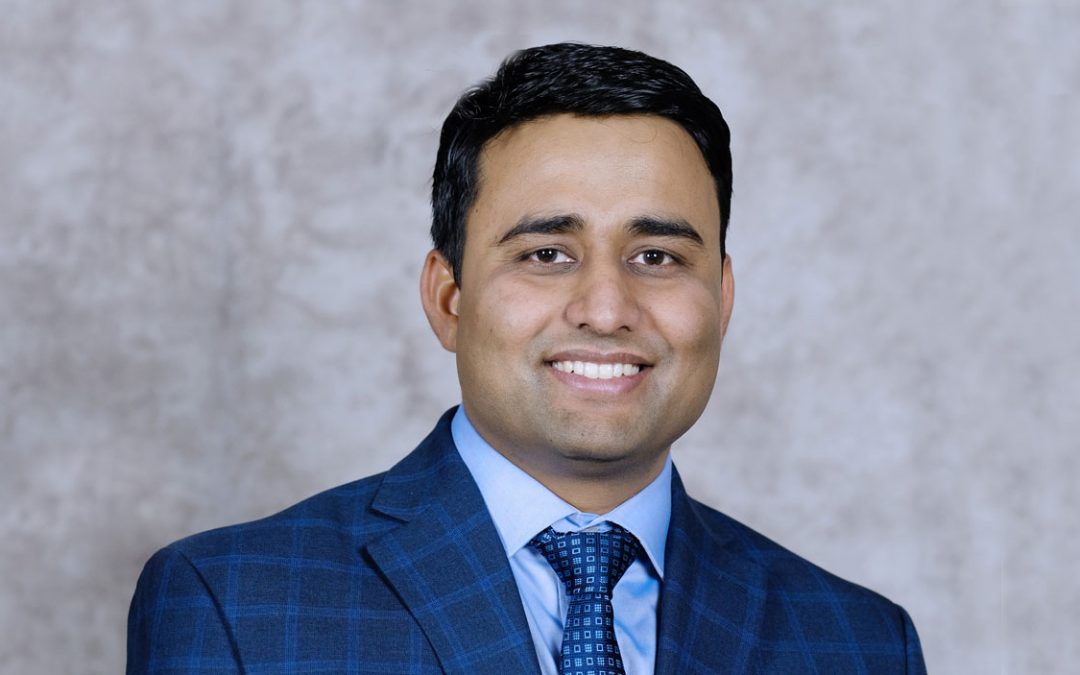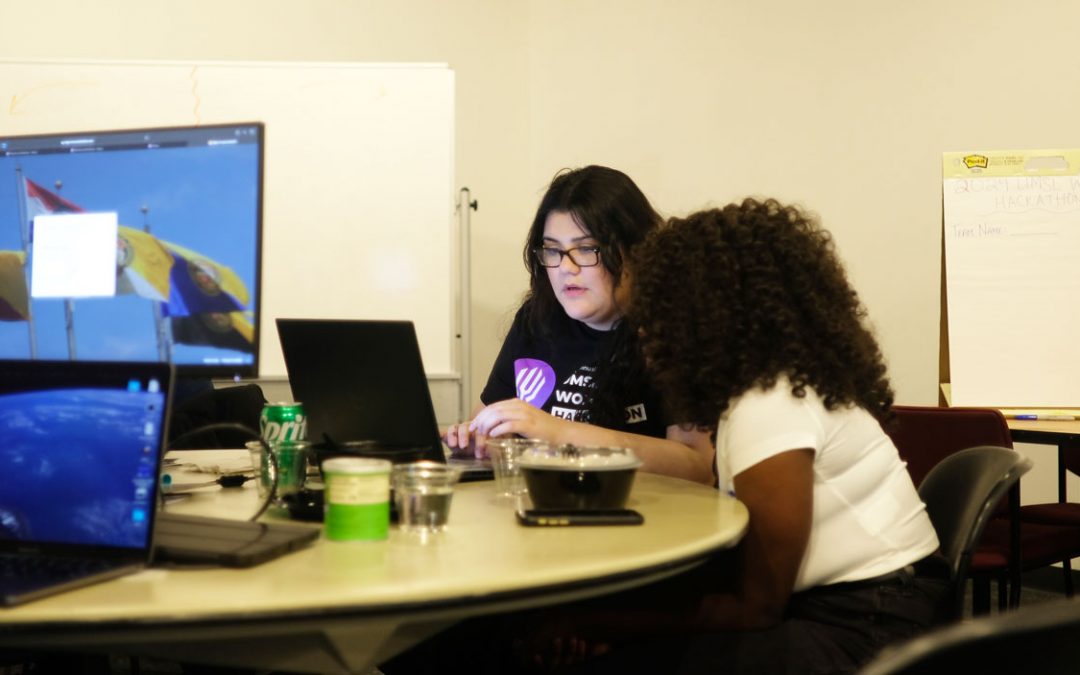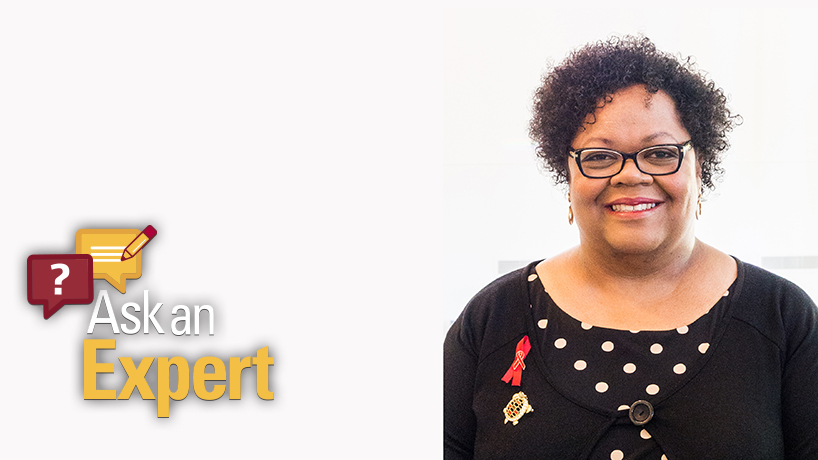
Assistant Professor of Nursing Sheila Grigsby’s eight-year experience as a HIV/AIDS Surveillance Coordinator for the City of St. Louis Department of Health helps her to educate students and the general community on the importance of public health tools. (Photo courtesy of Sheila Grigsby)
COVID-19 has fallen much harder on African Americans than everyone else in the city of St. Louis.
Of the approximately 2,000 reported cases of coronavirus, 1,256 were African Americans compared to 488 Caucasians. The deaths – 82 to 42 – tell a similar story.
Though states’ racial data reporting has been scattershot, that is a pattern that holds true throughout the United States. In order to discover why, what can be done and how the events after George Floyd’s death in Minneapolis have exacerbated the situation, UMSL Daily turned to University of Missouri–St. Louis Assistant Professor of Nursing Sheila Grigsby in this latest installment of our Ask an Expert series.
Grigsby, a community engagement fellow in the College of Nursing, focuses her teaching on community health nursing and parish nursing, and her research interests include reducing health disparities in the St. Louis region, teen pregnancy prevention, sexual and reproductive health and preventing chronic disease in the African American community by using community-based participatory research methods. Currently, her research focuses in faith communities on health disparities, social determinants of health and HIV/AIDS prevention. An extensive community organizer and health coalition builder, Grigsby was awarded the Pillar Award for Health and Wellness by the 100 Black Men of Metropolitan St. Louis in 2018 for her work leading nursing students through preventive health screenings in St. Louis area barber shops. Her eight-year experience as a HIV/AIDS Surveillance Coordinator for the City of St. Louis Department of Health helps her to educate students and the general community on the importance of public health tools such as surveillance and contact tracing to help control the spread of COVID-19 in the area.
Looking at coronavirus cases by race and zip code is pretty dramatic. How accurate do you think those numbers are?
We believe that the numbers are an underrepresentation of what’s really out there. There was a delay in St. Louis making testing available for residents in the city and north St. Louis County. In recent weeks we have seen more consistent testing in these areas. Many African Americans were turned away because they were told their symptoms were not COVID. They were explained away as being allergies or the flu, and they were never allowed to access the test. Oftentimes, if you don’t meet the strict CDC criteria, then they will turn you away. We need more testing sites that actually allow you to be tested if you don’t have all of the signs or symptoms.
Has the testing situation improved at all?
It is still happening because, if a person does not have a regular physician, it’s very hard to find someone to get a doctor’s order to receive the test. Many doctors’ offices don’t offer the tests, so they have to write the order for you. Access is a significant barrier.
Individuals without health insurance can go to Federally Qualified Health Centers. There are different pop-up testing centers available in the city and county now. More testing has become available as long as supplies are available. But it’s about knowing where to go and being tapped into those resources. Everybody doesn’t know where those places are or that they even exist.
Just this week, I was helping a friend that suspected that she had the virus. It took all day to find someplace to get tested. Her results were positive. Fortunately, she was given her test results in twenty-four hours. After being given her results and being put on quarantine, her sister had to take her son and mother around to find a place for them to get tested. Urgent cares in the area charge $100 just to be seen, not for the tests. It is a very big barrier. It’s something we really need to be talking about.
Are there structural problems that are making access to health care more difficult?
Absolutely. If a person works at a job that does not allow them paid time off, the incentive is not there to take time off if you are sick or experiencing symptoms. You’re going to miss your wages. You’re not going to be able to pay your bills. If you don’t have health insurance, that’s another barrier. If you don’t have a regular provider, that’s another barrier. The systems are not in place for you to be able to take off when you’re sick. If you are living in a multi-generational home, just like the case I shared with you, you are going to expose others. There is no such thing as isolation when you live with other people. A lot of the social distancing messages that were put out by the media did not consider people that don’t have access to health care. They don’t have sick time. The majority of African Americans work in jobs that are considered frontline workers. These workers make the least money but shoulder the most risk. They don’t have the option of being able to stay home and work from home. They had to report to work. These risks put you at a greater risk for contracting the virus
What role has health care communication played?
I think that the media has done a good job of trying to educate us on the disease, trying to educate us on the number of cases and ways to social distance. Again, I think it has to do with not necessarily being able to convey a complex message for people who are not easily able to socially distance. If you’re telling someone to isolate or quarantine, but that’s not an option for them, other options need to be explored and explained at a level that can be understood by those without a public health background. Same thing with the messages about not going to the emergency room. There were a lot of people that did not go to the emergency room because they had a fear that they were going to get the disease, but they ended up having other conditions, such as heart attacks, possible strokes or neglecting their general health because they have not gone to the doctor out of fear. Then you have to think about the behavioral health effects. Elderly people, their health declines the more that they socially isolate. People with existing behavioral health problems tend to do poorly as well.
How have coexisting conditions made coronavirus worse?
Older individuals that are in their late 40s, 50s, 60s are going to be more likely to have coexisting conditions, things such as hypertension, diabetes, maybe respiratory problems. These conditions don’t necessarily increase your likelihood of getting the disease, but if you do come in contact with the disease, you do have poorer outcomes. With diabetes, your circulation is compromised, your healing is compromised. This disease has been known to create blood clots. With respiratory problems, it’s harder for you to breathe, so one of the things with COVID-19 is it increases the mucus production in your lungs. If you already have a compromised respiratory system, it’s going to make it much harder for you to be able to get rid of the infection. The other piece to this is that people who are relatively healthy can be carriers, and not even know it. They might just have some mild signs or symptoms, but they could pass it on to someone who would have a much poorer outcome. That’s why the mask protects both of us. You’re protecting yourself, but you’re also protecting the people around you.
What do you think the role of nurses or nurse leaders is or should be during the pandemic?
I think that we should be resources to direct people on where testing is and how to get access to testing. I think that we should be educating people, general public or patient constituents, about what the disease is, about the needs of social systems, where the hotspots are in our community – talking with systems to help make plans for reintegration. Helping communities to develop a plan because when this comes back we won’t be able to shut down again. We’ll have to keep going. In the African American community, education about vaccines is important. There’s a lot of fear attached to vaccines and vaccine trials. But eventually we are going to have to talk about vaccines and getting our communities ready to accept that even though we might not know a lot about the vaccine will become important to discuss.
What would go into that education about vaccines?
I think educating people about the vaccine process, the clinical trial process but also helping people to understand that the vaccine or clinical trials, are going to be most effective with populations that participate. If we don’t have adequate participation from male and female representatives from different race ethnicities, the vaccine is not going to be as effective in those populations. So we have to participate. We have to be educated on the benefits and the possible challenges of taking it, but we’ve got to be part of the process and can’t just sit back and not participate. I think that African Americans have a tendency to not participate because of past treatment with the Tuskegee Syphilis Study and other experiments that have been done on African Americans.
To change topics a bit, you did research on the effects of civil unrest on health after Michael Brown’s death. How might that apply to what’s happening right now with protests after the killing of George Floyd?
I think it kind of goes back to what I said. Nursing roles are really to be advocates and activists, to be out there with the people and exercising our right to be able to peacefully protest to create awareness about the civil unrest going on in our community as well as the country right now. In regards to COVID-19 and people not social distancing, I’m very fearful of what we’re going to see because of that. I know that the recommendation is that people socially isolate if they participate in protests. But I don’t believe that they’re going to adhere to those recommendations. People choosing to protest despite the global pandemic happening simultaneously goes to show how strongly people feel about this issue. People have grown tired of being sick and tired. That is one reason why we see the reactions that we’re seeing now.
Has there been a nexus of current events that is creating a large health toll on the African American community?
I think that African Americans have historically had to deal with a lot of stress – more stress than any other culture. I think that we’ve learned how to manage it at the sake of our health and emotional well-being. We have developed coping mechanisms to deal with the stress and the discrimination that we face every day. This stress causes us to have disproportionate representation in diseases such as hypertension, diabetes, cancer – all linked back to stress, chronic stress, the absence of stress or feeling that threat all the time. This stress added to not having access to adequate health care, and not having the opportunity to develop the good habits of eating nutritional foods and having the ability to go to the gym because of our schedules. This exposes us to cancer and other debilitating diseases that lead to a shorter lifespan.
Is there anything else we haven’t discussed?
I hope that the university remains engaged with the community even though we’ve had to change how we interact. We have to figure out how we’re going to continue to interact with our neighbors and not close ourselves off because of COVID-19. During this challenging time, we have to be both innovative and inclusive in our approach to solutions. I want to be a part of this change.



